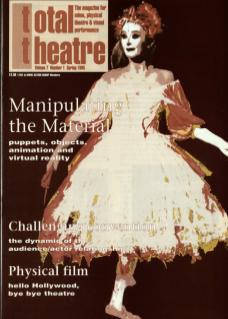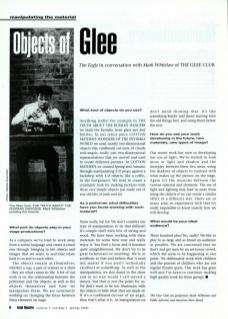What part do objects play in your stage productions?
As a company we've tried to work away from a verbal language and create a visual one through bringing to life objects and images that we relate to and that relate back to us and to each other.
The objects remain as themselves, whether a cup, a pair of scissors or a chair – they are what comes to life. A lot of our work is on the relationship between the performer and the objects, as well as the objects themselves and how we manipulate them. We are constantly working on changing the focus between these elements on stage.
What kind of objects do you use?
Anything really! For example in The Truth About the Russian Dancers we built the Kremlin from glass jars and bottles. In our latest piece Cotton Mather's Wonders of the Invisible World we used mostly two-dimensional objects like cardboard cut-outs of clouds and angels, really just two-dimensional representations that we moved and used to create different pictures. In Cotton Mather’s we created Spring and Autumn through manipulating 2D props against a backdrop with 3D objects, like a coffin, in the foreground. We tried to create a cinematic look by making pictures with these very simple objects just made out of any old bits of junk and tat.
As a performer what difficulties have you found working with such material?
None really, ha! ha! We don't consider our type of manipulation to be that difficult! It's simple stuff with bits of string and wood. We have been working with these materials for some time now and really enjoy it. You find a focus and it becomes quite straightforward. We don't try to be great technicians or anything. We're in antithesis to that and believe that it need not matter if you aren't technically excellent at something. As well as the manipulation, we also dance in the show and in no way would I call myself a dancer, but that is not the point for us. We don't want to be too illusionary with the objects or hide what they are made of. If it's a cardboard cut-out of an angel, then that's what it is. As manipulators we don't mind showing that. It's like something Brecht said about starting with the old things first, and using them before the new.
How do you see your work developing in the future, new materials, new types of image?
Our recent work has seen us developing our use of light. We've started to look more at light and shadow and the interplay between these two areas, using the shadows of objects to contrast with what makes up the picture on the stage. Again it's the tensions between the various material and elements. The use of light and lighting may lead us away from using the objects if we can create a similar effect in a different way. There are so many areas to experiment with that it's really impossible to know exactly how we will develop
What would be your ideal audience?
Three hundred plus! No, really! We like to play to as large and as broad an audience as possible. We are concerned that we don't just get seen by an art-house crowd, which did seem to be happening at one point. We deliberately work with children and the parents of children who are not regular theatre-goers. This work has gone well and I'm keen to continue making high quality work for these groups.
The Glee Club are performers Mark Whitelaw and Eddie Aylward, and musician Steve Mead.

